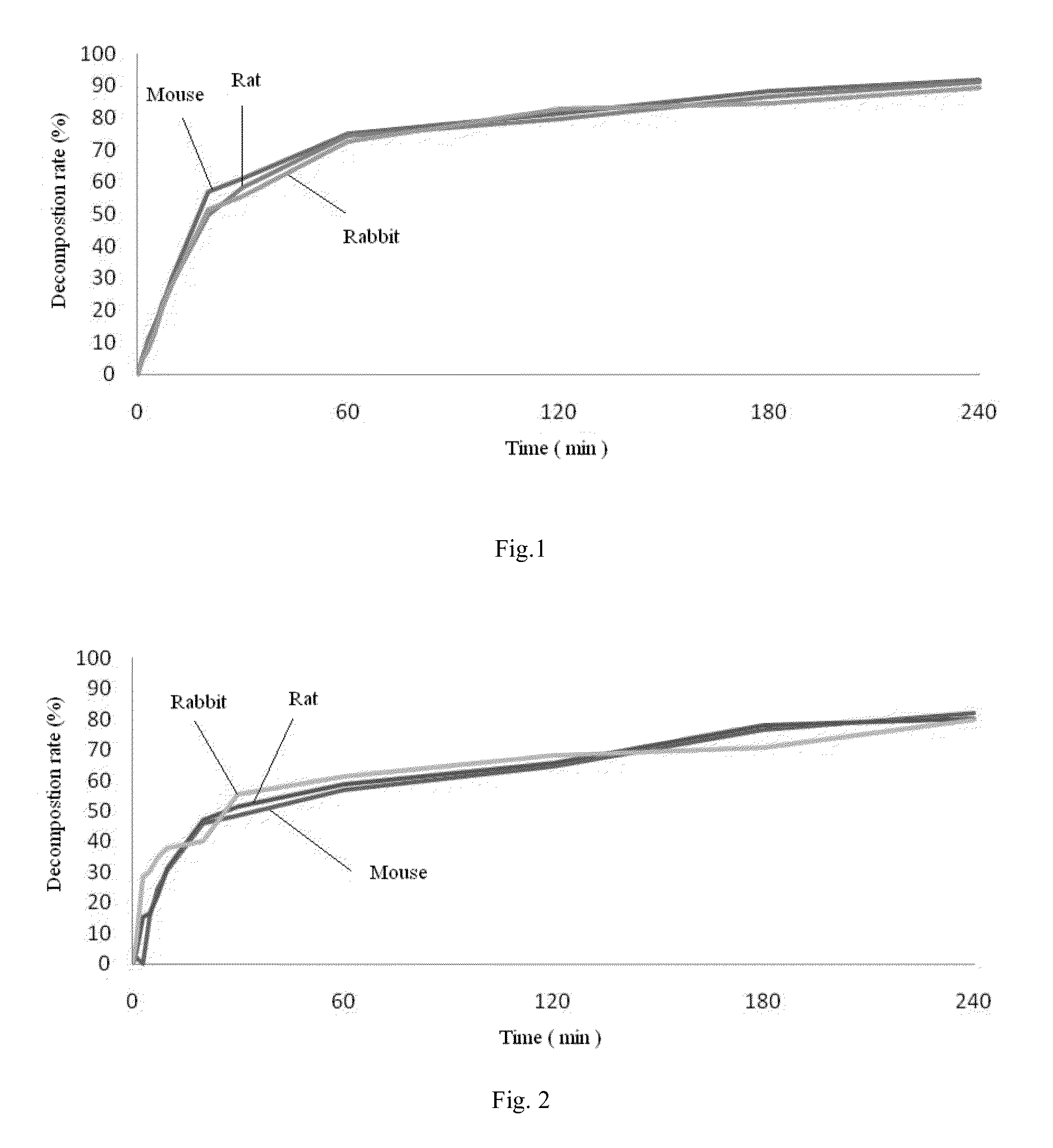Phosphate ester compound of hydroxy acid substituted phenol ester, preparation method and medical use thereof
a technology of hydroxy acid and phenol ester, which is applied in the directions of phosphorous compound active ingredients, drug compositions, biocides, etc., can solve the problems of still preparation, allergic reactions, and difficult storage when unsealed, and achieves the expansion of the application scope of propofol prodrug, the effect of improving the water solubility of propofol and increasing the stability of the prodrug in vitro
- Summary
- Abstract
- Description
- Claims
- Application Information
AI Technical Summary
Benefits of technology
Problems solved by technology
Method used
Image
Examples
example 1
[0020]20 g of propofol (II) was dissolved in 50 ml of triethylamine, added with 14 g of succinyl oxide and 0.02 g of DMAP (4-dimethylamino-pyridine). The mixture was reacted completely for 16 hours under stirring at room temperature, and the reaction solution was evaporated to remove triethylamine. The residue was added into 100 ml of water and adjusted to pH 1 with 6N HCl to produce a great amount of white precipitate. The precipitate was separated and then dried under reduced pressure to give crude propofol succinate monoester (IV), which was recrystallized with cyclohexane / ethyl acetate to obtain 23.5 g of acicular crystals. Yield: 75.4%, mp: 103-104° C.
[0021]2.54 g of sodium tetrahydroborate was suspended in 45 ml of anhydrous tetrahydrofuran, cooled to below 5° C., and then slowly added dropwise with 18 g of propofol succinic acid monoester (IV) in tetrahydrofuran, with the temperature maintaining below 5° C. After completion of the dropwise addition, the mixture was stirred un...
example 2
[0031]20 g of propofol was dissolved in 100 ml of methylene dichloride, added with 13.3 g of succinic acid, 0.02 g of DMAP, and then 23.2 g of DCC. The mixture was reacted for 6 hours under stirring at room temperature, then the reaction solution was filtrated to remove white solid, and the filtrate was washed once with 150 ml of 6N hydrochloric acid. The organic layer was separated and evaporated under reduced pressure to remove the solvent to give crude propofol succinate monoester (IV) as pale yellow solid, which was recrystallized with cyclohexane / ethyl acetate to obtain 26.6 g of white acicular crystals. Yield: 85%, mp: 102-103° C.
[0032]The method of preparing propofol w-hydroxybutyrate phosphate ester and / or its disodium salt (I) from propofol succinate monoester intermediate (IV) was similar to that of Example 1.
example 3
[0033]10 g of propofol (II) was dissolved in 50 ml of triethylamine, added with 7 g of glutaric anhydride (III) and 0.01 g of DMAP. The mixture was stirred for 12 hours at room temperature, and the reaction solution was evaporated under reduced pressure to remove excessive triethylamine. The residue was added into 100 ml of water and adjusted to pH 1 with 6N HCl to produce a great amount of white precipitate. The precipitate was separated and then dried under reduced pressure to give crude product, which was recrystallized with cyclohexane / ethyl acetate to obtain 10.8 g of propofol glutarate monoester intermediate (IV) as white flaky crystals. Yield: 65.9%, mp: 53-54° C.
[0034]2.54 g of sodium tetrahydroborate was suspended in 45 ml of anhydrous tetrahydrofuran, cooled to below 5° C., and then slowly added dropwise with 19 g of propofol glutarate monoester intermediate (IV) in 60 ml of tetrahydrofuran, with the temperature maintaining below 5° C. After completion of the dropwise addi...
PUM
| Property | Measurement | Unit |
|---|---|---|
| temperature | aaaaa | aaaaa |
| temperatures | aaaaa | aaaaa |
| pH | aaaaa | aaaaa |
Abstract
Description
Claims
Application Information
 Login to View More
Login to View More - R&D
- Intellectual Property
- Life Sciences
- Materials
- Tech Scout
- Unparalleled Data Quality
- Higher Quality Content
- 60% Fewer Hallucinations
Browse by: Latest US Patents, China's latest patents, Technical Efficacy Thesaurus, Application Domain, Technology Topic, Popular Technical Reports.
© 2025 PatSnap. All rights reserved.Legal|Privacy policy|Modern Slavery Act Transparency Statement|Sitemap|About US| Contact US: help@patsnap.com



